The Blue of Distance
MAUREEN DRENNAN • MARTHA FLEMING-IVES • MELVIN HARPER • MATTHEW HARVEY
SEPTEMBER 15 – OCTOBER 15, 2017
OPENING RECEPTION FRIDAY, SEPTEMBER 15, 6–9 PM
“The color of that distance is the color of an emotion, the color of solitude and of desire, the color of there seen from here, the color of where you are not. And the color where you can never go.” – Rebecca Solnit
Transmitter is pleased to announce The Blue of Distance, an exhibition of emerging artists who disrupt conventional notions of identity and address themes of alienation in their work, by operating within the space between connection and distance. Taking its title from an essay by Rebecca Solnit, which explores the color blue’s role as a metaphor for longing and desire, this exhibition features works reflecting personal narratives of isolation from larger communities due to race, gender, religion, mental health, or social inequality.
Photographer and educator Maureen Drennan has always been drawn to vulnerable people or communities that are isolated from mainstream society. Earlier this year, she met and photographed Arab women who have all endured various types of discrimination. In photographing young Arab-American women, she was interested in dispelling otherness. In The Blue of Distance, Drennan’s work focuses on one of her subjects, Adam. Adam is hijra, a transgender female of Pakistani descent.
Martha Fleming-Ives grew up in Northampton, MA and currently lives in Brooklyn, NY. Her work has been exhibited at Silver Eye Center for Photography, Center for Photography at Woodstock, Weatherspoon Art Museum, John Michael Kohler Arts Center, and Griffin Museum of Photography. She is currently an Adjunct Professor in the Honors Program at the School of Visual Arts, NY.
In Melvin Harper’s films he addresses race, gender, and identity, examining what it’s like to be perceived as an African-American man in the United States. Weaving together appropriated imagery from cell phone videos, dash cams, news footage, early science-fiction films, and Google searches, Harper considers issues of visibility and perception. In Harper’s films, conceived as a trilogy, his own disillusion with markers of identity and racial inequality are present—African-American men are juxtaposed to aliens, stuffed in cages, and unnecessarily brutalized because of their perceived otherness.
In Liquidation, Matthew Harvey seeks to detach himself from the familiarity and accumulated memories of objects through the sale of all of his possessions. Interested in separating from his meaningful belongings, he further dissociates from their personal significance through a transactional process, rendering them into inventory to be disposed of rather than objects to be cherished. Harvey’s installation features photographs of his objects arranged to resemble home decor catalog pages and a book, as well as printed matter that viewers can take away in order to inquire about items available for sale.










